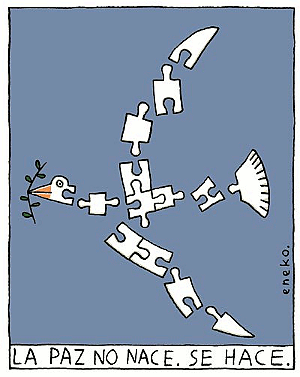Editorial

Research for peace and conflict resolution and transformation studies have long insisted on the importance of communication in the dynamics of conflicts and their resolution, in both their violent phase and at the point when the emphasis is placed on negotiations to obtain a ceasefire or the implementation of agreements and the construction of peace in the medium and long term. In addition, the crucial role of the new information and communication technologies in conflict resolution, and that of the global network of electronic communications and social networks in particular in the era of globalisation and cybertechnology, has also recently been stressed. Hence the importance of devoting the central topic of this issue to an in-depth review of the subject - the relationship between war, peace and communication. And hence some of the thoughts below.
It must be stressed, first, that although technology is not neutral, it has no implicit values: it all depends on who uses it and how. In the world of mass communication, technology is a double-edged sword. For example, the radio was used to announce a genocide (Radio Télévision Libre des Mille Collines, Rwanda, 1994), but it is also now being used as a tool in the Congo for bringing together women who have suffered from sexual violence to talk about their problems, and in Burundi to create an openly multi-ethnic radio station (the Ijambo project). There are other examples: the same mobile phones that need coltan to work and which have fuelled some wars are used to sell minerals and buy weapons on the international markets every day, and in a pioneering experiment in Burundi, are used to train 8,000 local leaders in conflict resolution and are used by them to work with their communities. In other words, the media, including social networks, can be used to inform, educate, empower and therefore as connecting or binding factors, and to create stereotypes, stir up violence, create division and to legitimise violent solutions and fractures of the social fabric by means of cultural violence. As a result, despite the highly encouraging role of social networks in the Arab uprisings or in the creation of the movement for the regeneration of democracy called "15 May" in Spain which camped in squares in the country's major cities, they can also used for completely antagonistic purposes. To paraphrase McLuhan, the medium is indeed the message, as shown by the limitations on the number of characters in Twitter, but the message can be very varied.
Second, it should be remembered that the journalists who cover armed conflicts or peace-building processes do so in the face of strong contextual constraints, restrictions on access to information under difficult conditions, with collective mental frameworks and perceptions from which they cannot entirely detach themselves. And we know that in conflicts, perceptions, stereotypes and mental images of the other, about the identity of the enemy, are crucial. In any event, the major new development since the Cold War has been the discovery that journalists and the media can also play a dual double-edged role, often unconsciously, in encouraging the legitimisation of violence (as is often said, they have a "warmaking" role) but can also be a factor in the construction of peace. In this regard, we reproduce the simple and easy to apply proposals by Lynch and Galtung 1.
They offer some practical principles for engaging in responsible journalism in terms of building peace, based around 6 recommendations:
- 1 Avoid the simplifications that arise when presenting conflicts as two opposing positions about a single subject, when many causes are usually involved and various actors are engaged.
- Avoid presenting the conflicting parties as a confrontation between good and evil.
- Cover peace initiatives from the elites and the grassroots, and explore everyday ways of coping with the conflict.
- Use precise language, avoiding words that are too emotive or dehumanising labels.
- Pay attention to the shared goals and common foundations between the parties.
- Strive to avoid perceptive dysfunctions, using the most accurate information possible.
In other words, the two observations can be summarised with the help of short phrases from two classics of synthetic thought. Be aware of the difficulty in communicating, because as George Bernard Shaw said, "the single biggest problem in communication is the illusion that it has taken place." And remember that as the Stoic Epictetus said, before talking you should understand the meaning and implications of what you are about to say. Taking both of the above into account, the opportunities in an almost permanently connected world are enormous.
Rafael Grasa
1. J Lynch/J Galtung, Reporting conflict: New Directions in Peace Research Journalism, Brisbane, University of Queensland Press, 2010. (Back)